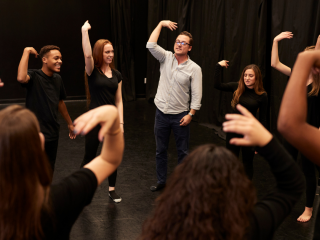Imagine being a teenager again. On top of the challenges that can come with these formative years, you struggle with even basic social skills. You feel less coordinated and physically self-aware than your peers. You’re constantly inundated with a dozen different voices in your head all jockeying for attention. Your mind is either on fast forward or rewind almost all the time. You easily become overwhelmed by commotion. Now imagine walking into a drama classroom. Yikes. This is the reality that neurodivergent students face daily. If you’re like me and you’re gearing up for the start of a new school year, you’re probably thinking about ways to set up your classroom in a way that will make every student feel comfortable and optimize their learning experience.
What’s Neurodivergence?
Broadly defined, the terms neurodivergence and neurodiversity refer to variations in socialization, emotions, learning, and focus. They’re usually used in the context of neurodevelopmental conditions like autism and ADD/ADHD, but can also refer to dyslexia, Tourette’s, and various learning/processing disorders. The terms re-frame the binary idea that there are “normal” brains and “abnormal” brains and instead emphasize that variations are natural and normal.

Drama classes offer both unique challenges and opportunities for neurodivergent students. Our classrooms often become spaces of safety and comfort for students, especially those who feel “different”. As curators of those spaces, it’s important to facilitate the growth and learning of those students while also validating them and honoring what they bring to the classroom. So, what does the ideal drama classroom look like for neurodivergent students?
Establish the Culture
Demonstrating from day one that you will cultivate a space that honors diversity can go a long way in setting up students for success. Of course you don’t want to force the issue, but don’t shy away from having conversations and giving students the opportunity to share their experience and challenges with neurodiversity if they want to. I like handing out index cards and having students put their name, preferred pronouns, and anything they want me to know that will help them succeed and feel comfortable in the class. I also use a questionnaire at the beginning of the year where I ask what they’re most nervous about and what challenges they think they might have in the class.
You’ll want to make sure to establish clear procedures that you expect students to follow as well, especially when it comes to what students should do when they become overstimulated. When some of my students started just walking out of the room when they got overwhelmed, I established a “take five” system. They give me a “high five” hand signal, and once I acknowledge with a simple nod or thumbs up, they are allowed to go reset just outside the room. One of the tenets of the procedure is that I will stick my head out and check on them after five minutes.
Representation Matters
Building a library of plays that represent neurodiversity and using those plays in your curriculum is a great way to help students feel seen and valued. The Curious Incident of the Dog in the Night-Time is probably the most well-known play that deals with neurodiversity (the main character has autism). Some other scripts you might consider include Falling by Deanna Jent, The Other Room by Ariadne Blayde, Body Awareness by Annie Baker, and All in a Row by Alex Oates. Of course, you can also have students write their own plays reflecting their experiences. Or consider using a verbatim theatre lesson in which students can interview each other and then create a script around those interviews.
Meet Them Where They Are
This goes without saying, but working with neurodivergent students in the drama classroom requires an extra level of sensitivity and grace. Neurodivergent individuals often have a low threshold for frustration, so students may act out and say or do things that make it seem like they don’t care. When this happens, I like to remember the advice of one of my mentors: “assume good will”. It’s easy to give in to knee-jerk reactions, but rarely does that do any real good. It’s perfectly okay to take a pause and allow everyone to reset. Having a quick sidebar with a student and initiating a conversation with “can you tell me why you’re frustrated?” or “tell me what you’re feeling” can help the student start to better understand their emotions, which can help with the emotional regulation many neurodivergent students struggle with. Some students may have no idea what they’re feeling, or how to articulate it. If that’s the case, “tell me what you’re thinking” may work better. Behavior is communication, especially when it comes to neurodivergent students.

Take It Literally
Neurodivergent students often think very analytically and literally. For example, when I was working with a student on the autism spectrum, I said “grab a seat”, and he quite literally picked up his seat. I once told a student that he had cool hair and jokingly said “it’s not fair”. The student looked confused and kind of hurt, and I realized that he had probably thought I was literally saying that it wasn’t fair that he had cool hair and I didn’t. So you’ll want to be very mindful of how you word things – specificity is always a good thing.
Routine, Routine, Routine
All students need structure and routine. In many cases, they actually prefer it (whether they know it or are willing to admit it or not). This is even more true of neurodivergent students. I was surprised to hear some fellow educators once discussing how annoyed they get when students ask “what are we doing today?” Their reasoning is that the question has a subtext: “how little can I get away with doing today?” For some students that is indeed the case. But I’ve found that the only students who regularly ask me this question are those who struggle with anxiety or who need structure and predictability. Simple additions to your classroom can help with this. I put up a small whiteboard where I write a daily outline so students have a basic game plan and know what to expect for the day.
I also use the same basic structure for almost every class period. Each day starts with a quick check-in, then, we move into the lesson and end with a “Rabbit Hunt”, using the last five or ten minutes of class to reinforce main ideas and allow students to ask any nagging questions or share any thoughts they have about the lesson (I call those questions and thoughts “rabbits running around in your brain”, hence the name “rabbit hunt”).
Move Slowly…Literally
Let’s face it, teenagers in general tend to lack physical awareness, which is understandable. After all, their bodies are rapidly changing. But neurodivergent students in particular often struggle with this. One characteristic of ADD/ADHD, for example, is lack of coordination and kinesthetic awareness. Students on the autism spectrum often struggle with proprioception, the awareness of posture, movement, and balance. This can make movement work more difficult and frustrating for students, so they may benefit from more individual coaching to identify specific needs. A key here is to make individual coaching part of your overall teaching so that students don’t feel singled out.
It’s also helpful to be really specific with your vocabulary and descriptions of what you’re doing – modeling usually isn’t enough. I’ve found instructions that are specific, concrete, and image-based to be helpful. For example, one of my students was struggling with walking in a direct line and always tended to stray sideways without even realizing it. When working with them on some blocking, I drew lines on the floor with chalk and had them follow the lines at various speeds. I then gave them three specific destinations on stage and told them to imagine that their nose had a string attached to it and they were being pulled to point A, then point B, then point C. This is an area where your “teacher radar” will help you find the best ways to approach your individual students’ needs. Look for opportunities to turn it into a game as well.

Offer Meaningful Choices
Giving neurodivergent students as much agency as possible is a great way to offer them a valuable learning experience, even if you’re not quite able to get them outside of their comfort zone. If students are anxious about participating in an activity or presenting a monologue, I allow them to do a written observation response instead. Technology is also a great tool here. Students can record their monologues or presentations on Flipgrid if they’re not comfortable doing it in front of the class.
Feedback is a critical component to performing arts classes, but neurodivergent students may be particularly sensitive to criticism. Many people with ADD/ADHD experience some level of rejection sensitive dysphoria, a disproportionately negative emotional response to even minor criticism or the perception of rejection. This often results in anxiety about feedback. A structured feedback process can help here. When my students give initial feedback to their peers’ work, they respond to specific prescribed questions: “what did you see?” and “what do you wonder?”. Depending on the class, I might use “what do you want more of”, either in addition to the other two or in place of “what do you wonder”.
With this format, students know what to expect when their work is critiqued and it helps minimize prescriptive or inadvertently hurtful feedback. Then, the student who just performed has the option to ask the audience questions about the scene/monologue. I give them a sheet with potential questions, like “were there any moments where you couldn’t hear me clearly?”, but they can ask pretty much anything they want. This part of feedback is always optional, but more often than not students will feel more comfortable taking advantage of the opportunity because they’re in the driver’s seat.
Keep It Casual
The overall vibe of the classroom can go a long way in helping make neurodivergent students feel more comfortable. When it comes to vulnerable moments like performing or presenting in front of the class, I like to keep things more casual. When students perform a scene or monologue, we call it “sharing” or “offering”. The audience is spaced out and I encourage students to grab a yoga mat and sit on the floor if they want. I found that as long as I reinforced from the beginning that audience etiquette always applies, the more casual format works well and helps reinforce my “process over product” mentality.
Avoid Sensory Overload
It can be easy for neurodivergent students to become overwhelmed by things like lights and loud sounds. This is an area that can get a little tricky. After all, theatre kids are notoriously rowdy. You certainly don’t want to discourage reasonable play and enthusiasm, but you also want to cultivate an environment that serves the needs of students who are sensitive to overstimulation. This is another area where establishing clear expectations and boundaries from the beginning helps. You’ll definitely want to set a signal that you can give when things are getting a little too rowdy (the basic “let’s take five please” or “if you can hear my voice, pause and take a breath” work fine in my experience).
It’s always a good idea to have a spot somewhere in the room where students can go if they need to reset. I have a simple chair in the corner of the room with a sign that says “Zen Chair” that a student can go sit in if they’re anxious or overwhelmed.

Take Every Opportunity to Learn
When I first started teaching, I learned quickly that neurodivergent students had various and specific needs in the drama classroom. It felt overwhelming and a little scary at first – I didn’t want to say or do the wrong thing and I certainly didn’t want to be the reason that a student became discouraged by theatre. I’ve gotten more comfortable, but I’m still learning. The key is to take every opportunity to learn what you can about neurodivergence. Sometimes the best teachers are the students themselves – if a student has signaled that they’re open to sharing, it’s okay to ask them about their needs and experiences. Students may or may not remember everything you teach them. But they will always remember how you made them feel. What “best practices” have you found in your classroom?















